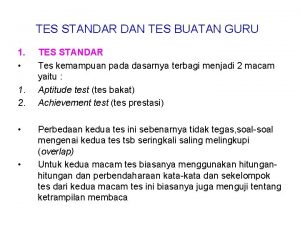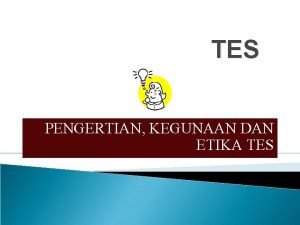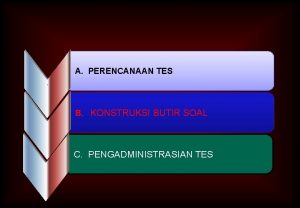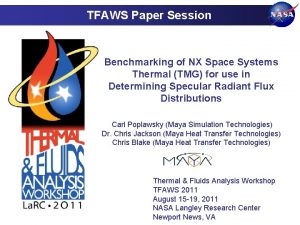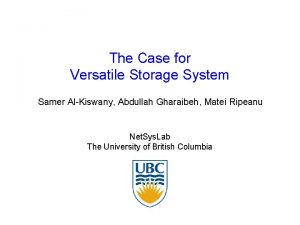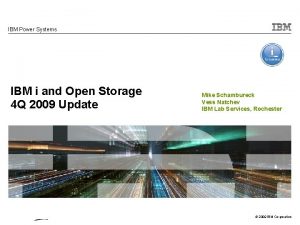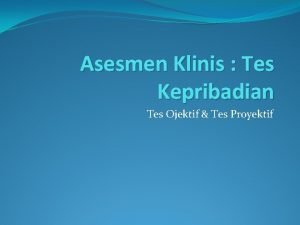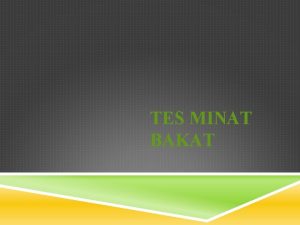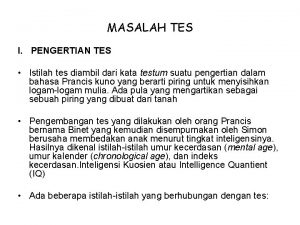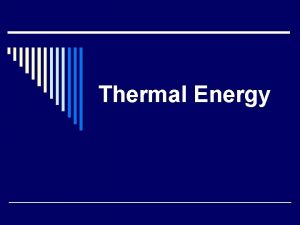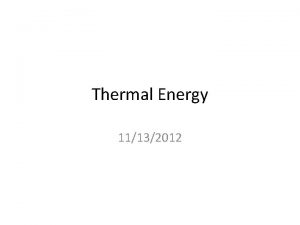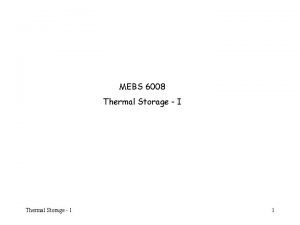Thermal Energy Storage Thermal energy storage TES systems














- Slides: 14

Thermal Energy Storage • Thermal energy storage (TES) systems heat or cool a storage medium and then use that hot or cold medium for heat transfer at a later point in time. • Using thermal storage can reduce the size and initial cost of heating/cooling systems, lower energy costs, and reduce maintenance costs. If electricity costs more during the day than at night, thermal storage systems can reduce utility bills further. • Two forms of TES systems are currently used. The first system used a material that changes phase, most commonly steam, water or ice. The second type just changes the temperature of a material, most commonly water. 1

TES Economics Are Attractive for • High utility demand costs • Utility time-of-use rates (some utilities charge more for energy use during peak periods of day and less during off-peak periods) • High daily load variations • Short duration loads • Infrequent or cyclical loads 2

Why Use TES for Space Cooling? • Shifts electricity demands to the night to take advantage of lower rates at night • Can also be a way to take advantage of wind power, which is more abundant at night http: //www. calmac. com/benefits/ 3

Grid Electricity Exhaust Facility Electricity Auxiliary Power Electricity Produced Power Generation (Gas Turbine) Electric Chiller Heat Recovery System Heat Carrier Storage Tank Input Fuel Chiller Power Boiler Chilled Fluid Absorption Chiller Demand Storage Tank Σ Heat Exchanger Heat Carrier Waste Heat Electricity Flow Fuel Flow Thermal Flow Energy flows in a combined heat and power system with thermal storage (Wang, et al. 2010)

TES with Concentrated Solar Power (CSP) • CSP technologies concentrate sunlight to heat a fluid and run a generator • By coupling CSP with TES, we can better control when the electricity is produced 5

Control Strategy • Feedforward + Feedback (PID) temperature control – Uses FF measurements of solar irradiance – Flow rate of stream 1 is manipulated variable • Feedback control (PID) used for steam flow (power) control • Supplemental gas used when solar energy is not sufficient (stream 4) 6

Storage Tank Model Mass Balance Energy Balance 7

Boiler Model Energy Balances: Heat Transfer Fluid Boiler 8

500 400 300 200 Solar Radiation (W/m 2) Solar Energy and the Need for Storage 700 600 100 0 0: 00 A 1. P 1 23: 00 A 12. P 12 22: 00 A 12. P 12 21: 00 A 12. P 12 20: 00 A 12. P 12 19: 00 A 12. P 12 18: 00 A 12. P 12 17: 00 A 12. P 12 16: 00 A 12. P 12 15: 00 A 12. P 12 14: 00 A 12. P 12 13: 00 A 12. P 12 12: 00 A 12. P 12 11: 00 A 12. P 12 10: 00 A 12. P 12 9: 00 A 12. P 12 8: 00 A 12. P 12 7: 00 A 12. P 12 6: 00 A 12. P 12 5: 00 A 12. P 12 4: 00 A 12. P 12 3: 00 A 12. P 12 2: 00 A 12. P 12 1: 00 A 12. P 12 0: 00 A 12. P 12 Time of Day 9

Results: Sunny Day, System without Storage (No Power Control) 10

Results: Sunny Day, System with Storage and Power Control 11

Results: Cloudy Day, System without Storage (No Power Control) 12

Results: Cloudy Day, System with Storage and Power Control 13

Summary of Results Solar Energy Delivered to Load Supplemental Fuel Required (MWh) Solar Share Sunny Day: System without Storage 16. 48 Sunny Day: Cloudy Day: System with Storage without Storage 16. 82 8. 40 8. 49 12. 58 7. 18 15. 78 15. 51 47. 6% 70. 1% 34. 3% 35. 4% • Solar Share increased by 47% on sunny day, 3% on Cloudy day • Power quality much better with storage • Dynamic optimization with weather forecasts can further improve solar share 14
 Thermal energy section 3 using thermal energy
Thermal energy section 3 using thermal energy Contoh soal tes standar
Contoh soal tes standar Ethic test
Ethic test Contoh konstruksi butir soal
Contoh konstruksi butir soal Press dalam tat
Press dalam tat Thermal energy vs heat energy
Thermal energy vs heat energy Thermal energy and mass
Thermal energy and mass Thermal transfer vs direct thermal printing
Thermal transfer vs direct thermal printing Nx space systems thermal
Nx space systems thermal Primary storage vs secondary storage
Primary storage vs secondary storage Secondary storage vs primary storage
Secondary storage vs primary storage Uses rigid metallic platters
Uses rigid metallic platters Unified storage vs traditional storage
Unified storage vs traditional storage Samer al-kiswany
Samer al-kiswany Storage for ibm power systems
Storage for ibm power systems

